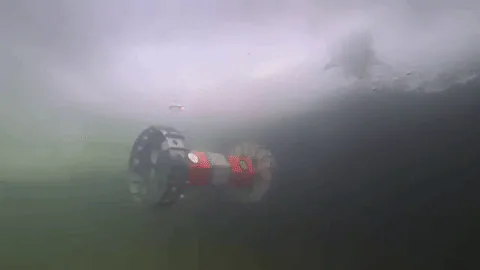Ridges on the surface of Jupiter's moon Europa could mean water — and life
Researchers analyzing similar ridges on Greenland's ice sheet found water underneath


Scientists have found that Jupiter's moon Europa may have liquid water relatively near the surface, which increases the possibility of the existence of life.
"It was really surprising and exciting," said lead study author Riley Culberg in an interview with Quirks & Quarks host Bob McDonald. "Suddenly we're discovering new things about a different part of our solar system that we just didn't understand before."
Europa is one of Jupiter's largest moons. It has long fascinated scientists because it is covered in a layer of ice up to 30 kilometres thick, and data suggests that this ice shell floats on top of an ocean that ranges from 60-150 kilometres deep.

Because of this, it has long been considered a prime candidate for hosting life, as liquid water is thought to be an essential ingredient for evolving and maintaining life. But considering the depth and thickness of the ice shell, it would be incredibly difficult to get to for an exploratory mission.
The possible presence of shallow water changes that.
"Maybe these kinds of shallow water pockets are themselves habitable, or at least preserve evidence of life from a subsurface ocean that might be easier to access," said Culberg.
The research was published in the journal Nature Communications.
Looking to Greenland's ice sheet for clues
The team were looking at geographic features in the ice called double ridges. "If you were to cut one of these in half and look at the cross-section, it would look a lot like the capital letter M," said Culberg, a PhD student in electrical engineering at Stanford University.
"And on Europa, these are really large. Maybe 150 to 200 metres tall, and they can be up to 500 kilometres long. And we really see them all over the moon."

Culberg typically studies climate change impacts on the Greenland ice sheet. When talking with a colleague who studies Europa, they noted that these double ridges were present on both ice sheets. And even though the terrestrial ridges are only two metres tall, their shapes suggested they were formed in the same way.
"There's a rather characteristic ratio between the distance between the two peaks of the ridge and the total height of the ridge," said Culberg. "So it gives us a sense that maybe the same kind of processes are at play, even though the absolute scale of these things is quite different."
Using data from missions such as NASA's Operation Ice Bridge, which gathers detailed imagery of Greenland's ice sheet and how it is formed, Culberg and his team were able to peer underneath the double ridge here on Earth. They found the ridge was being formed by a big pocket of water melting and refreezing, which would expand and push the ice sheet up to create the ridge.

"That interior core of liquid water was basically able to explode upwards and push up these two ridges at the surface," he said. He believes the same would be happening on Europa.
"In order to get these kinds of liquid water pockets inside of the shell, water would really have to be coming from the bottom up. So perhaps it's getting forced up from the ocean through fractures into the ice shell, or possibly there could be some kind of internal melting of these rising plumes of warm, buoyant ice."
Looking for life under the ice
NASA engineers have been hard at work designing robotics and rovers that could explore the icy moon.
"It's one of the most promising locations in our solar system for where we might find other signs of life," NASA engineer Andy Klesh told McDonald in 2020. Klesh is currently testing a robot that would explore where the ice and water meet, which is the most likely spot for life.

"Algae and microbes tend to use photosynthesis and actually anchor on that underside of the ice where they themselves can be protected from the currents that are around there in the air," said Klesh. "Certainly there won't be a lot of light [on Europa], but there will still be that anchoring point for many of the different microbes.
Culberg adds that it will be much easier to find life if missions don't have to go through 30 kilometres of ice to find it.
"Shallow water certainly makes it an easier target if we're trying to look for it with scientific imaging, or with some kind of access or sampling," he said.

While Klesh's rover is still at least a decade away from being put to work, there are several other missions to Europa in various stages of planning and development.
NASA hopes to launch the Europa Clipper mission in a couple of years, which will provide researchers like Culberg a better look at what's happening underneath the ice.
"We're really excited that [The Europa Clipper spacecraft] has an ice-penetrating radar on it, because that's exactly the instrument we used in Greenland to study this double ridge. And so there's going to be some exciting data coming out of the Clipper mission for looking for these kinds of processes," he said.
Produced and written by Amanda Buckiewicz